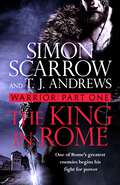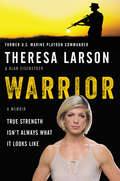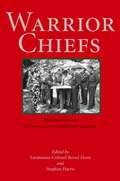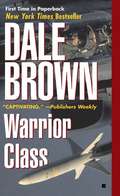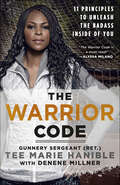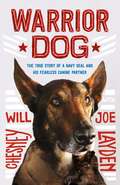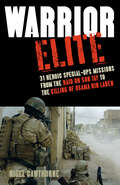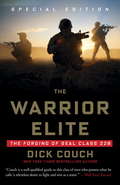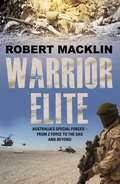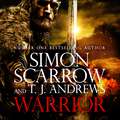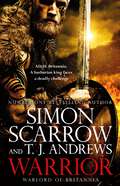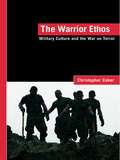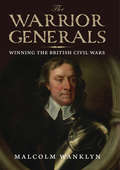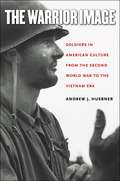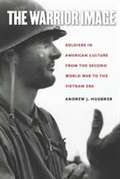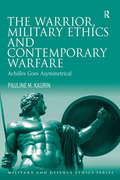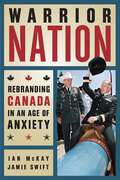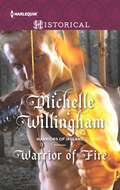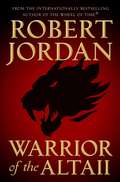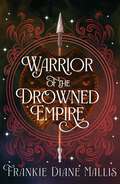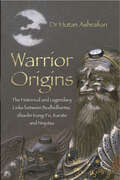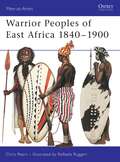- Table View
- List View
Warrior: Part One of the Roman Caratacus series (Warrior)
by Simon Scarrow T. J. AndrewsWARRIOR: THE KING IN ROME is the first episode of the story of Caratacus - barbarian enemy of Rome. ALSO COMING SOON (IN NOVEMBER 2022): DEATH TO THE EMPEROR - the thrilling new Eagles of the Empire adventure. Pre-order now!AD 61. Rome. Boudica's rebellion against Roman rule has failed. At a celebratory banquet, an ambitious historian, Caius Placonius Felicitus, takes an interest in a mysterious guest: Caratacus. Once a high king of Britannia, now living in exile, Caratacus gradually opens up to Felicitus. And the young Roman soon realises that Caratacus's is the story he has been waiting all his life to tell.AD 18. Britannia. Caratacus's tale begins as he - quick-witted youngest son of the tribal king Cunobelinus - humiliates his own brother in a war of wits. Cunobelinus decrees that the teenage prince continue his studies under the Druids at a sinister sanctuary, nestled in a remote valley in the lands of the Silures . . . But Caratacus will need all his new skills, as well as his natural cunning, to survive . . .The brand new series from the Sunday Times bestselling authors of Invader and Pirata: Warrior, the story of Britannia's barbarian warlord Caratacus.
Warrior: The Autobiography of Ariel Sharon
by Ariel SharonThe autobiography of one of the most controversial personages in contemporary Israel with his comments on his life, the military, government workers and politics.
Warrior: A Memoir
by Theresa Larson Alan EisenstockIn this inspiring memoir, a former female Marine platoon leader recalls the wars she has fought--on the playing field, the battlefield, and inside her own soul--revealing how overcoming the harrowing circumstances in her life helped her ultimately redefine what it means to be strong and what "perfect" really is.Theresa Larson has lived multiple lives. At ten she was a caregiver to her dying mother. As an adolescent, an All-Star high school, college, and professional softball player. As a young adult, a fitness competition winner, beauty pageant contestant, and model. And as a grown woman, a high-achieving Lieutenant in the Marines, in charge of an entire platoon while deployed in Iraq.Meanwhile, Theresa was battling bulimia nervosa, an internal struggle which ultimately cut short her military service when she was voluntarily evacuated from combat. Theresa's journey to wellness required the bravery to ask for help, to take care of herself first, and abandon the idea of "perfect." In Warrior, she lays bare all of these lives in intimate and vivid detail, examining extremely personal and sometime painful moments and how, by finally accepting the help of others, she learned to make herself whole. From growing up in a log cabin outside Seattle to facing down the enemy in Iraq, Theresa's journey demonstrates that good health and happiness is a daily, intentional act that requires persistence and commitment.Theresa hopes that through sharing her story, she will help inspire others to empower themselves, embrace their inner warrior and re-define strength. Startling and funny, terrifying and triumphant, heartbreaking and inspirational, Warrior is at heart a story of perseverance and success--of a determined woman who is model for everyone struggling to conquer their own demons. Theresa shows that asking for help can be an act of courage, and that we are stronger than we think when faced with seemingly impossible odds.
Warrior Chiefs: Perspectives on Senior Canadian Military Leaders
by Colonel Bernd Horn Stephen HarrisThey were the men who led our nation in war and peace. In world wars, they were the steady hands guiding our forces to victory; in peacekeeping, they helped to establish and preserve order. Over the years they have helped the Canadian Forces to become one of the proudest militaries in the world. Warrior Chiefs: Perspectives on Senior Canadian Military Leaders is the first book of a two-part series that examines the unique Canadian experience and outlook in regard to Generalship and the Art of the Admiral. This first volume is a compendium of biographies of the nation’s most notable military leaders from Confederation to the post-Cold War era. Personalities include: Sir William Otter, Sir Sam Hughes, E.L.M. Burns, G.G. Simonds, Charles Foulkes, Andy McNaughton, J.V. Allard, and J. Dextraze, to name only a few.
Warrior Class (Patrick McLanahan Series #9)
by Dale BrownRussia is collapsing, and oil magnate Pavel Kazakov seizes the opportunity to take control, using the Russian army to back him up with deadly force.
The Warrior Code: 11 Principles to Unleash the Badass Inside of You
by Denene Millner Tee Marie HanibleFrom American Grit co-star, former Marine Gunnery Sergeant Tee Marie Hanible comes the story of how she became a warrior...and how you can do it, too.In The Warrior Code, entrepreneur, philanthropist, reality star, and retired Gunnery Sergeant Tee Marie Hanible serves up eleven principles to awaken your inner badass and thrive in the face of adversity.After surviving the death of her father, enduring foster care, and being expelled from school, Tee joined military reform school, where she began uncovering her inner warrior. As part of one of the first female classes of recruits to complete the Marine Corps Crucible and the Marine Combat Training, and as the only woman to deploy with her unit to Iraq in 2003, Tee tested her mettle and learned the key to becoming an unbreakable woman. With insightful honesty and wisdom, and set against the backdrop of Tee’s life, The Warrior Code will help you understand that things can beat us back from realizing our true potential...but the key is finding the way to realize one’s own innate strength.
Warrior Dog (Young Readers Edition): The True Story of a Navy SEAL and His Fearless Canine Partner
by Joe Layden Will ChesneyTwo dozen Navy SEALs descended on Osama bin Laden’s compound in May 2011. After the mission, only one name was made public: Cairo, a Belgian Malinois and military working dog. Warrior Dog is the story of Cairo and his handler, Will Chesney, a member of SEAL Team Six whose life would be irrevocably tied to Cairo's, specially adapted for young readers from Chesney and Joe Layden's No Ordinary Dog. Starting in 2008, when Will was introduced to the canine program, he and Cairo worked side by side, depending on each other for survival on hundreds of critical operations in the war on terrorism. But their bond went beyond their military service. As Cairo aged and went on fewer missions, Will moved on to other assignments, forced to slowly—and painfully—distance himself from the dog. Then, in 2011, the call came: Pick up your dog and get back to Virginia. Now.Cairo and Will trained for weeks for a secret mission, but it soon became clear that this was no ordinary operation. Cairo was among the first members of the U.S. military on the ground in Pakistan as part of Operation Neptune Spear, which resulted in the successful elimination of bin Laden.As Cairo settled into a role as a reliable “spare dog,” Will went back to his job—until a grenade blast in 2013 left him severely injured. Unable to participate in further missions, he tried to recover, medicine provided only modest relief. Instead, it was up to Cairo to save Will's life once more—and then up to Will to be there when Cairo needed him the most.
Warrior Elite: 31 Heroic Special-Ops Missions from the Raid on Son Tay to the Killing of Osama bin Laden
by Nigel CawthorneHeart-pounding accounts of the courageous men, elite methods, and deadly moments that make up daring special ops missions. They are the strongest, best-trained and most powerfully equipped soldiers in the world. The select few who overcome near-impossible odds. The special ops forces. Presenting real-life stories that read like fictional thrillers, Warrior Elite recounts over two dozen of modern warfare’s mostriveting, dangerous, and infamous missions. From support amid the lethal chaos of major combat operations, like the rescue of Private Jessica Lynch in Iraq, to targeted military strikes against rogue enemies, like the Navy SEAL sniper shots that saved Captain Richard Phillips from Somali pirates, these are the missions that test the gut level of even the bravest soldier. Warrior Elite brings readers into the heart of the battle to experience the hectic horror of Black Hawk Down, the blind terror of Tora Bora cave warfare, and the triumphant success of MIA rescue missions deep in Laos.
The Warrior Elite: The Forging of SEAL Class 228
by Dick CouchWith a postscript describing SEAL efforts in Afghanistan, The Warrior Elite takes you into the toughest, longest, and most relentless military training in the world.What does it take to become a Navy SEAL? What makes talented, intelligent young men volunteer for physical punishment, cold water, and days without sleep? In The Warrior Elite, former Navy SEAL Dick Couch documents the process that transforms young men into warriors. SEAL training is the distillation of the human spirit, a tradition-bound ordeal that seeks to find men with character, courage, and the burning desire to win at all costs, men who would rather die than quit.
Warrior Elite: Australia's special forces Z Force to the SAS intelligence operations to cyber warfare
by Robert MacklinA compelling account of Australia's intelligence organisations and special forces - from the early days of the commandos during World War II through to the SAS of today and the cyber wars of the future. From the co-author of SAS Sniper.Warrior Elite is a unique and compelling account of Australia's special forces and intelligence operations - ranging from the early special forces of World War II to the establishment and development of the SAS and Commando Regiments as the elite fighters of today, and from the Australian Security Intelligence Service to the Australian Signals Directorate and ASIO. It is an authoritative, gripping and thoroughly up-to-date account of both the history and current state of our special forces and intelligence bodies - and gives a unique glimpse into the warfare of the future. Our future.Robert Macklin has conducted dozens of exclusive interviews and uncovered incredible, daring and sometimes heartbreaking stories of the elite troops that guard our nation and engage in secret operations around the world. He has had significant cooperation from numerous sources within the special forces and the various intelligence agencies.Both thoroughly researched and colourfully written, Warrior Elite will attract the reader of action memoirs as well as those interested in broader military history and espionage.
Warrior: The epic story of Caratacus, warrior Briton and enemy of the Roman Empire… (Warrior)
by Simon ScarrowFrom the bestselling author of the Eagles of the Empire novels comes the epic story of Caratacus: a barbarian who united tribes to raise an army against mighty Rome . . .The Romans invaded Britannia in AD 43 confident of victory. They swept through a divided and ill-equipped enemy, scattered across tough terrain. But one man was not prepared to surrender. Caratacus - quick-witted youngest son of a a tribal king - had been trained from birth to be a warrior of power and grit. Sent to be schooled by the Druids in his boyhood, his training meant that an already strong and cunning prince returned to his father's kingdom as a war machine . . .With Caratacus driving them forward, the tribes prepare to repulse an enemy anticipating an easy victory. Fighting not only to stay alive but for their very way of life, these men form a mighty force. The battle is on!The brand new series from the Sunday Times bestselling authors of Invader and Pirata: Warrior, the story of Britannia's barbarian warlord Caratacus.(p) 2023 Headline Publishing Group Ltd
Warrior: The epic story of Caratacus, warrior Briton and enemy of the Roman Empire…
by Simon ScarrowAD 18, Britannia.The Roman Empire rules much of the known world. Beyond the northern frontier lies Britannia, where ceaseless feuding amongst the Celts leaves the island vulnerable to Rome's ambitions.Caratacus, son of a powerful king, has no premonition of destiny when he is dispatched to train with the Druids. A brutal regime transforms the young prince into a warrior with unparalleled military skills - and the strategic cunning essential to outwit a stronger enemy.Nothing can prepare a man for the vicious reality of war. When Caratacus's father takes a stand against aggressive neighbouring tribes, the combat exercises are over; this is a fight to the death. Only the most ruthless of tactics offer any hope of victory. But Caratacus, and the loyal comrades willing to ride with him into hostile terrain, are ready to do whatever it takes - and endure any hardship - to defeat those set on destroying their kingdom . . .As mayhem and carnage spread across the land, everywhere can be felt the malign influence of Rome. Even if the battle is won, conflict with the Empire lies ahead.The brand new series from the Sunday Times bestselling authors of Invader and Pirata: Warrior, the story of Britannia's barbarian warlord Caratacus.Originally published in 5 ebook novellas
Warrior: The epic story of Caratacus, warrior Briton and enemy of the Roman Empire…
by Simon ScarrowAD 18, Britannia.The Roman Empire rules much of the known world. Beyond the northern frontier lies Britannia, where ceaseless feuding amongst the Celts leaves the island vulnerable to Rome's ambitions.Caratacus, son of a powerful king, has no premonition of destiny when he is dispatched to train with the Druids. A brutal regime transforms the young prince into a warrior with unparalleled military skills - and the strategic cunning essential to outwit a stronger enemy.Nothing can prepare a man for the vicious reality of war. When Caratacus's father takes a stand against aggressive neighbouring tribes, the combat exercises are over; this is a fight to the death. Only the most ruthless of tactics offer any hope of victory. But Caratacus, and the loyal comrades willing to ride with him into hostile terrain, are ready to do whatever it takes - and endure any hardship - to defeat those set on destroying their kingdom . . .As mayhem and carnage spread across the land, everywhere can be felt the malign influence of Rome. Even if the battle is won, conflict with the Empire lies ahead.The brand new series from the Sunday Times bestselling authors of Invader and Pirata: Warrior, the story of Britannia's barbarian warlord Caratacus.Originally published in 5 ebook novellas
The Warrior Ethos: Military Culture and the War on Terror (LSE International Studies Series)
by Christopher CokerThis is the first scholarly book to look at the role of the 'warrior' in modern war, arguing that warriors' actions, and indeed thoughts, are increasingly patrolled and that the modern battlefield is an unforgiving environment in which to discharge their vocation. As war becomes ever more instrumentalized, so its existential dimension is fast being hollowed out. Technology is threatening the agency of the warrior and this volume paints a picture of early twenty-first century warfare, helping to explain why so many aspiring warriors are becoming disenchanted with their profession. Written by a leading thinker on warfare, this book sets out to explain what makes an American Marine a ‘warrior’ and why suicide bombers, or Al Qaeda fighters, do not qualify for this title. This distinction is one of the central features of the current War on Terror – and one that justifies much more extensive discussion than it has so far received. The Warrior Ethos will be of great interest to all students of military history, strategy, military sociology and war studies.
The Warrior Generals: Winning the British Civil Wars
by Malcolm WanklynIn this bold history of the men who directed and determined the outcome of the mid-seventeenth-century British wars--from Cromwell, Fairfax, and Essex to many more lesser-known figures--military historian Malcolm Wanklyn offers the first assessment of leadership and the importance of command in the civil wars.
The Warrior Image
by Andrew J. HuebnerImages of war saturated American culture between the 1940s and the 1970s, as U.S. troops marched off to battle in World War II, the Korean War, and the Vietnam War. Exploring representations of servicemen in the popular press, government propaganda, museum exhibits, literature, film, and television, Andrew Huebner traces the evolution of a storied American icon--the combat soldier.Huebner challenges the pervasive assumption that Vietnam brought drastic changes in portrayals of the American warrior, with the jaded serviceman of the 1960s and 1970s shown in stark contrast to the patriotic citizen-soldier of World War II. In fact, Huebner shows, cracks began to appear in sentimental images of the military late in World War II and were particularly apparent during the Korean conflict. Journalists, filmmakers, novelists, and poets increasingly portrayed the steep costs of combat, depicting soldiers who were harmed rather than hardened by war, isolated from rather than supported by their military leadership and American society. Across all three wars, Huebner argues, the warrior image conveyed a growing cynicism about armed conflict, the federal government, and Cold War militarization.
The Warrior Image: Soldiers in American Culture from the Second World War to the Vietnam Era
by Andrew J. HuebnerImages of war saturated American culture between the 1940s and the 1970s, as U.S. troops marched off to battle in World War II, the Korean War, and the Vietnam War. Exploring representations of servicemen in the popular press, government propaganda, museum exhibits, literature, film, and television, Andrew Huebner traces the evolution of a storied American icon--the combat soldier. Huebner challenges the pervasive assumption that Vietnam brought drastic changes in portrayals of the American warrior, with the jaded serviceman of the 1960s and 1970s shown in stark contrast to the patriotic citizen-soldier of World War II. In fact, Huebner shows, cracks began to appear in sentimental images of the military late in World War II and were particularly apparent during the Korean conflict. Journalists, filmmakers, novelists, and poets increasingly portrayed the steep costs of combat, depicting soldiers who were harmed rather than hardened by war, isolated from rather than supported by their military leadership and American society. Across all three wars, Huebner argues, the warrior image conveyed a growing cynicism about armed conflict, the federal government, and Cold War militarization.
The Warrior, Military Ethics and Contemporary Warfare: Achilles Goes Asymmetrical (Military and Defence Ethics)
by Pauline M. KaurinWhen it comes to thinking about war and warriors, first there was Achilles, and then the rest followed. The choice of the term warrior is an important one for this discussion. While there has been extensive discussion on what counts as military professionalism, that is what makes a soldier, sailor or other military personnel a professional, the warrior archetype (varied for the various roles and service branches) still holds sway in the military self-conception, rooted as it is in the more existential notions of war, honor and meaning. In this volume, Kaurin uses Achilles as a touch stone for discussing the warrior, military ethics and the aspects of contemporary warfare that go by the name of 'asymmetrical war.' The title of the book cuts two ways-Achilles as a warrior archetype to help us think through the moral implications and challenges posed by asymmetrical warfare, but also as an archetype of our adversaries to help us think about asymmetric opponents.
Warrior Nation: Rebranding Canada in an Age of Anxiety
by Ian McKay Jamie SwiftOnce known for peacekeeping, Canada is becoming a militarized nation whose apostles—-the New Warriors-—are fighting to shift public opinion. New Warrior zealots seek to transform postwar Canada’s central myth-symbols. Peaceable kingdom. Just society. Multicultural tolerance. Reasoned public debate. Their replacements? A warrior nation. Authoritarian leadership. Permanent political polarization. The tales cast a vivid light on a story that is crucial to Canada’s future; yet they are also compelling history. Swashbuckling marauder William Stairs, the Royal Military College graduate who helped make the Congo safe for European pillage. Vimy Ridge veteran and Second World War general Tommy Burns, leader of the UN’s first big peacekeeping operation, a soldier who would come to call imperialism the monster of the age. Governor General John Buchan, a concentration camp developer and race theorist who is exalted in the Harper government’s new Citizenship Guide. And that uniquely Canadian paradox, Lester Pearson. Warrior Nation is an essential read for those concerned by the relentless effort to conscript Canadian history.
Warrior of Ice
by Michelle WillinghamLocked in a deadly game! Physically and emotionally scarred, Lady Taryn knows no man would want her for a wife. Nonetheless, she's determined to free her father from his merciless overlord and enlists powerful warrior Killian MacDubh to help. He has his own motives for confronting the High King... Born a bastard, Killian longs to carve out a place for himself. Unaware of her true beauty, Taryn is an alluring distraction to his plan, but as traitors are revealed and loyalties tested, their forbidden love becomes the only thing worth fighting for!
Warrior of the Altaii
by Robert JordanEpic fantasy legend, and author of #1 New York Times bestselling series The Wheel of Time®, Robert Jordan's never-before published novel, Warrior of the Altaii:Draw near and listen, or else time is at an end.The watering holes of the Plain are drying up, the fearsome fanghorn grow more numerous, and bad omens abound. Wulfgar, a leader of the Altaii people, must contend with twin queens, warlords, prophets and magic in hopes of protecting his people and securing their future. Elspeth, a visitor from another world, holds the answers, but first Wulfgar must learn to ask the right questions. But what if the knowledge that saves the Altaii will also destroy them?“Jordan has come to dominate the world Tolkien began to reveal.” —The New York Times Explore Robert Jordan's epic fantasy masterpiece, and enter the realm of The Wheel of Time®Prequel: New Spring#1 The Eye of the World#2 The Great Hunt#3 The Dragon Reborn#4 The Shadow Rising#5 The Fires of Heaven#6 Lord of Chaos#7 A Crown of Swords#8 The Path of Daggers#9 Winter's Heart#10 Crossroads of Twilight#11 Knife of DreamsBy Robert Jordan and Brandon Sanderson#12 The Gathering Storm#13 Towers of Midnight#14 A Memory of LightBy Robert Jordan and Teresa PattersonThe World of Robert Jordan's The Wheel of TimeBy Robert Jordan, Harriet McDougal, Alan Romanczuk, and Maria SimonsThe Wheel of Time CompanionBy Robert Jordan and Amy RomanczukPatterns of the Wheel: Coloring Art Based on Robert Jordan's The Wheel of TimeAt the Publisher's request, this title is being sold without Digital Rights Management Software (DRM) applied.
Warrior of the Drowned Empire: the hotly anticipated fourth book in the Drowned Empire romantasy series (Drowned Empire Series #13)
by Frankie Diane MallisWarrior of the Drowned Empire is the highly-anticipated fourth book in a sensational romantic series. Perfect for fans of Jennifer L. Armentrout, Danielle L. Jensen, and Rebecca Yarros.The Guardians have returned.As Moriel's reincarnation nears, Lyr is determined to fulfil her oath: harness the power of the red shard and defeat him.But Lyr has uncovered the Empire's darkest secret - her cousin Jules still lives and the Emperor is enslaving vorakh for their forbidden magic. Now, she's vowed to bring the Empire to its knees.But freeing the realm will require more power than even Lyr and Rhyan combined possess. Their only opportunity is to make a far more sinister deal with the person who has the most to gain - and the person Rhyan trusts the least.To protect her loved ones, Lyr must master her magic or risk unleashing destruction across the Empire. It could cost her everything - her heart. And soul.A LUSH ROMANTASY, INSPIRED BY CLEOPATRA AND FEATURING A HIGH-STAKES MILITARY ACADEMY AND DEADLY FORBIDDEN ROMANCE.'One fantastical world. One fierce heroine to take it down! Daughter of the Drowned Empire is sexy, thrilling, and pure magic!' Cecy Robson, author of BloodguardReaders love the Drowned Empire series!'I haven't read a book that's dragged me in as much as this since I discovered Throne of Glass' ⭐⭐⭐⭐⭐'I loved this. The tension, angst - it was exactly what I look for in a good back!' ⭐⭐⭐⭐⭐'The romance is *chefs kiss*. For fans of Throne of Glass or people who like high fantasy!! It's worth it, I promise you' ⭐⭐⭐⭐⭐'This is the kind of book that I can definitely see conquering the heart of many and being the next surprise hit' ⭐⭐⭐⭐⭐'If you are ready for an ancient world full of mages, warriors, fallen gods, and forbidden love, then you need to read Daughter of the Drowned Empire IMMEDIATELY' ⭐⭐⭐⭐⭐
Warrior of the Drowned Empire: the hotly anticipated fourth book in the Drowned Empire romantasy series (Drowned Empire Series #4)
by Frankie Diane MallisWarrior of the Drowned Empire is the highly-anticipated fourth book in a sensational romantic series. Perfect for fans of Jennifer L. Armentrout, Danielle L. Jensen, and Rebecca Yarros.The Guardians have returned.As Moriel's reincarnation nears, Lyr is determined to fulfil her oath: harness the power of the red shard and defeat him.But Lyr has uncovered the Empire's darkest secret - her cousin Jules still lives and the Emperor is enslaving vorakh for their forbidden magic. Now, she's vowed to bring the Empire to its knees.But freeing the realm will require more power than even Lyr and Rhyan combined possess. Their only opportunity is to make a far more sinister deal with the person who has the most to gain - and the person Rhyan trusts the least.To protect her loved ones, Lyr must master her magic or risk unleashing destruction across the Empire. It could cost her everything - her heart. And soul.A LUSH ROMANTASY, INSPIRED BY CLEOPATRA AND FEATURING A HIGH-STAKES MILITARY ACADEMY AND DEADLY FORBIDDEN ROMANCE.'One fantastical world. One fierce heroine to take it down! Daughter of the Drowned Empire is sexy, thrilling, and pure magic!' Cecy Robson, author of BloodguardReaders love the Drowned Empire series!'I haven't read a book that's dragged me in as much as this since I discovered Throne of Glass' ⭐⭐⭐⭐⭐'I loved this. The tension, angst - it was exactly what I look for in a good back!' ⭐⭐⭐⭐⭐'The romance is *chefs kiss*. For fans of Throne of Glass or people who like high fantasy!! It's worth it, I promise you' ⭐⭐⭐⭐⭐'This is the kind of book that I can definitely see conquering the heart of many and being the next surprise hit' ⭐⭐⭐⭐⭐'If you are ready for an ancient world full of mages, warriors, fallen gods, and forbidden love, then you need to read Daughter of the Drowned Empire IMMEDIATELY' ⭐⭐⭐⭐⭐
Warrior Origins: The Historical and Legendary Links between Bodhidharma, Shaolin Kung-Fu, Karate and Ninjutsu
by Hutan AshrafianWarrior Origins is an account of the history and legends of the world’s prominent martial arts and how they share a common heritage. It chronicles the origins of the Shaolin warrior monks, Shaolin Kung-Fu and their celebrated founder, Bodhidharma, who is also considered the first patriarch of Zen (Chan) Buddhism. The book considers Bodhidharma’s origins in the context of ancient Persia and its royal houses and continues with the rise of Karate from ancient Okinawan roots to Japan and then into a global sport. It connects the record of Ninja and Ninjutsu and the influence of some of its latter luminaries, including Seiko Fujita, whilst also revealing new evidence on renowned martial artists such as Bruce Lee. This work takes a dramatically original approach to the heart of the martial arts and their founders. Author Dr Hutan Ashrafian, who holds black belt grades in several martial art styles, including a 5th Dan in Okinawan Goju-Ryu Karate and championship medals in Karate and Judo at World and European Masters level, delineates the inheritance of these arts using innovative evolutionary approaches to find previously unidentified links between them. Warrior Origins traces the pattern from Bodhidharma to the remarkable diversity of modern martial arts.
Warrior Peoples of East Africa 1840-1900
by Raffaele Ruggeri C. J. PeersLess well known than the Zulu of South Africa, the warriors of East Africa had just as fearsome a reputation. This fascinating study, illustrated with rare early drawings and meticulous colour plates, covers six of most prominent tribes. The prowess of the lion-hunting Masai deterred all foreign penetration for most of the 19th century; the Ngoni, driven north by the Zulu, revolutionized warfare in the region; the HeHe put up fierce resistance to German colonisers; the Ruga-Ruga produced two formidable warlords and adorned themselves with bloody trophies; the Nandi showed reckless bravery even against machine guns; and the Turkana dominated one of the most pitiless wildernesses in all of Africa.
